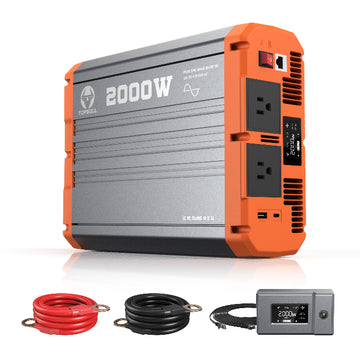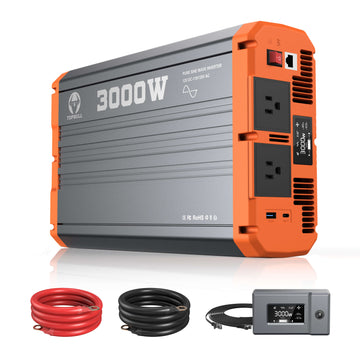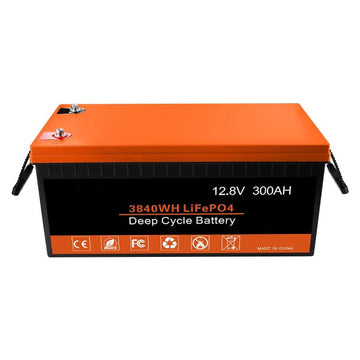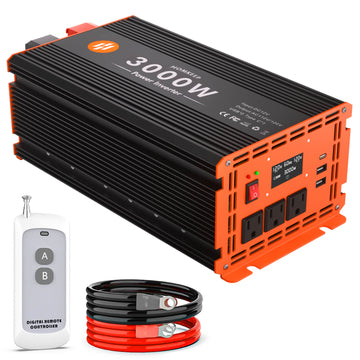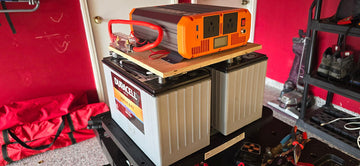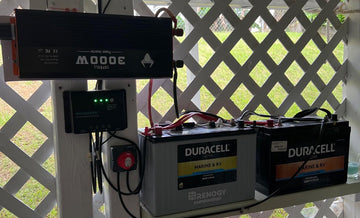Power inverters are incredibly useful for turning your car's DC battery power into usable AC electricity—perfect for road trips, camping, tailgating, or charging devices when you're far from a wall outlet. But one common concern always pops up: Do power inverters drain my car battery?
Unfortunately, the answer is: Yes. A power inverter can drain your battery, even when it's turned off, due to standby power consumption. The effect is even more significant when the inverter is actively running connected devices. But how fast does it happen? Can it be prevented? And what type of inverter is safest for your car battery?
In this complete guide, we'll explain exactly how inverters affect your battery, how to avoid unnecessary drain, and which Topbull car power inverters offer the best protection and performance for your needs.
Understanding Power Inverters' Impact on Car Batteries
A car power inverter is a device that converts 12V direct current (DC) from your vehicle's battery into 110V or 120V alternating current (AC)—the same type of power used in your home. This allows you to run tools and devices while on the road, including power tools like drills, chainsaws, and sanders, as well as household electronics such as laptops, smartphones, mini-fridges, portable fans, and even small kitchen appliances.
Power inverters draw energy directly from your car battery to generate usable AC electricity. As a result, they can cause battery drain, especially if you're powering high-wattage devices or running the inverter for extended periods. Several key factors determine how much power the inverter pulls from your battery:
-
Inverter Efficiency: High-efficiency models (like Topbull's car inverters) convert power more effectively, minimizing energy waste.
-
Device Power Consumption: Appliances with higher wattage draw more current and deplete the battery faster.
-
Usage Duration: The longer the inverter runs, the more power it consumes.
- Engine Status: When the engine is off, the alternator isn't recharging the battery—so drain happens much faster compared to when the car is running.
Even when idle or in standby mode, many inverters consume a small amount of power unless physically disconnected. This is why using the right inverter and managing usage habits is critical to preserving your car battery's health.
Why and When a Power Inverter Will Drain Your Car Battery
As we've learned, a power inverter will drain your car battery, even when the inverter is turned off, due to standby power consumption. However, the speed and severity of battery drain depend on several practical factors, which every driver or camper should understand to avoid unexpected battery issues.
Inverter Efficiency
The efficiency of your inverter directly affects how much power is drawn from the battery. High-efficiency pure sine wave inverters, like those from Topbull, reduce unnecessary energy loss during the DC-to-AC conversion, helping to conserve battery life. Cheaper or modified sine wave inverters may consume more power even under light loads.
Load Power Consumption
The more powerful the device you're running, the faster your battery will drain. For example, charging a phone uses minimal power, while powering a microwave, electric kettle, or mini fridge can deplete your battery much quicker. The wattage of the connected load plays a crucial role.
Battery Capacity and Condition
A healthy, high-capacity 12V car battery can support inverter use for longer periods. In contrast, older or underperforming batteries discharge more quickly, especially when used to power multiple devices or high-wattage appliances.
Understanding these factors is essential, but how do they play out in actual driving or camping situations? Let's look at a few real-world usage scenarios to see how inverter use can affect your car battery in everyday life.
Real-World Usage Scenarios
-
Light Use: Using a 150–300W inverter to charge a laptop for 1–2 hours with a healthy battery and the engine off typically won't cause major drain.
-
Heavy Use: Running a 1000W+ appliance (like a coffee maker) for more than 30 minutes without the engine running can significantly reduce battery charge, sometimes enough to prevent your car from starting.
- Standby Drain: Even when not in use, many inverters draw a small standby current. Over time, this can slowly discharge the battery if left connected.
How Fast Will a Power Inverter Drain a 12V Battery?
Understanding how long a 12V battery will last using a power inverter depends on the inverter's load and your battery's capacity. Here's how you can estimate runtime in real-life scenarios.
How to Calculate Battery Runtime
To estimate how long your battery will last when powering devices through an inverter, use this formula:
Battery Runtime (hours) = (Battery Capacity in Ah × 12V × 0.85) ÷ Load Wattage
- The 0.85 factor accounts for typical inverter efficiency (around 85%).
- This calculation assumes the car engine is off, so the battery is not being recharged during operation.
Example:
If you're using a 100Ah deep-cycle battery to power a 200W device:
(100 × 12 × 0.85) ÷ 200 = 5.1 hours
This means the battery can support that load for approximately 5.1 hours before being fully discharged.
Sample Scenarios:
| Load Device | Power Draw | 100Ah Battery Runtime |
| Smartphone charger | 20W |
~51 hours
|
| Laptop | 65W |
~15 hours
|
| Mini fridge | 120W | ~8.5 hours |
| Microwave | 800W | ~1.2 hours |
Note: These values are approximations and may vary depending on battery age, temperature, and inverter quality. Always monitor battery voltage to avoid deep discharge.
How to Use a Power Inverter in a Car Without Draining the Battery
Using power inverters for cars wisely can help you enjoy their convenience without risking a dead battery. Here are some essential tips to help you use it safely and efficiently.
-
Avoid Extended Use with the Engine Off: Whenever possible, run your inverter only while the engine is running. This allows the car's alternator to recharge the battery and offset power loss.
-
Minimize Idle Consumption: Even when no devices are connected, inverters draw a small amount of standby power. Always unplug or turn off the inverter when it's not in active use.
-
Use a Low-Voltage Cutoff Inverter: Invest in an inverter that includes a low-voltage protection feature. This shuts the inverter down automatically before the battery reaches dangerously low levels, preventing deep discharge.
- Check Battery Health Regularly: Weak or aging car batteries drain faster and struggle to recover after a deep discharge. Regular maintenance ensures your battery can safely support inverter use.
Best Secure Power Inverter in Cars that Protects Your Battery
Choosing the right inverter is just as important as using it properly. The ideal inverter should offer high efficiency, smart protection features, and enough power to match your needs, all without draining your battery unnecessarily.
Topbull's pure sine wave inverters are engineered with advanced safety features and battery protection in mind. Each model offers high power conversion efficiency to minimize energy loss, built-in overload and short circuit protection for safe operation, and automatic low-voltage shutdown to prevent deep battery discharge.

Here are three Topbull models tailored to different usage scenarios:
2000W Pure Sine Wave Inverter:
- Perfect for laptops, fans, phone chargers, and other light appliances.
- Compact, portable, and energy-efficient.
- Ideal for solo travelers, digital nomads, and light-duty car use.
3000W Pure Sine Wave Inverter:
- Capable of powering mini-fridges, microwaves, power tools, and more.
- Great for RVs, mobile workshops, and long-term car camping setups.
- Balanced between performance and energy management.
4000W Pure Sine Wave Inverter:
- Supports multiple high-power devices running simultaneously.
- Designed for off-grid living, emergency backup, or heavy-duty automotive needs.
- Maximum output with smart battery protection built in.
With built-in protection and optimized performance, Topbull inverters help you make the most of your car's power — safely and reliably.
How to Install a Power Inverter in a Car
After picking the best car inverter option, installing it in your car properly is also crucial for both performance and safety. Follow these steps to ensure a secure and efficient setup.
Step 1. Choose the Right Location
Mount the inverter as close to the battery as possible to minimize voltage drop, but ensure it's in a well-ventilated area to avoid overheating. Avoid enclosed spaces like under seats or in glove compartments. If possible, mount it on a flat, secure surface in the trunk or near the engine bay (away from heat sources).
Step 2. Connect the Inverter to the Car Battery
Use high-quality, thick-gauge power cables to handle the inverter's current draw—typically 4 AWG or thicker for inverters over 1000W. Connect the red cable to the positive battery terminal and the black cable to the negative terminal or vehicle ground. For longer cable runs, opt for heavier gauge wire to avoid voltage loss.
Step 3. Use a Fuse or Circuit Breaker
For safety, always install an inline fuse or circuit breaker on the positive (red) cable, as close to the battery as possible (within 18 inches). This protects against short circuits and overloads, which could otherwise damage the inverter or even start a fire.
Step 4. Ground the Inverter Properly
A solid ground connection is essential for safe operation. Connect the inverter's ground terminal to a clean, unpainted metal part of the vehicle's chassis. Use a short, thick grounding cable to minimize resistance and ensure stable power delivery.
Step 5. Test Before Use
Once connected, start the vehicle's engine, power on the inverter, and test it with a low-wattage device (like a phone charger or small fan). Make sure the inverter runs smoothly without triggering protection modes. This confirms that your connections are solid and the setup is working correctly.
You May Also Need:
How to Install a Power Inverter in a Truck [Best Guide]
How to Install a Power Inverter in an RV [Step by Step Guide]
Still have questions? Check out the most common concerns about using inverters in cars below.
FAQs About Car Power Inverter Usage
Can you run an inverter all the time?
Technically, yes, but it's not recommended unless the engine is running. Continuous inverter use with the engine off can quickly drain your battery and shorten its lifespan.
Should I leave my inverter connected to the car battery?
It's best not to. Leaving the inverter connected while the vehicle is off can lead to phantom drain. Always unplug the inverter when not in use to preserve battery charge.
What size inverter is safe for a regular car battery?
Inverters rated under 400W are generally safe for short-term use on a standard car battery. For higher wattage or extended use, consider a deep-cycle battery or keep the engine running to maintain battery health.
Can a car inverter kill your battery overnight?
Yes. If a power inverter is left running overnight, especially with high-power devices and the engine off, it can completely drain or even damage your car battery.
Conclusion
Power inverters are incredibly useful for running electronics and appliances while traveling, camping, or during emergencies. However, power inverters will drain your car battery, especially if misused or left running with the engine off. Choosing the correct wattage, and following best practices, like avoiding extended use while parked, you can enjoy convenient mobile power without risking battery damage.
To ensure safe, efficient, and battery-friendly operation, consider investing in Topbull car power inverters. With high conversion efficiency, built-in protection features, and reliable performance, they're the ideal choice for anyone who wants dependable power on the road.

